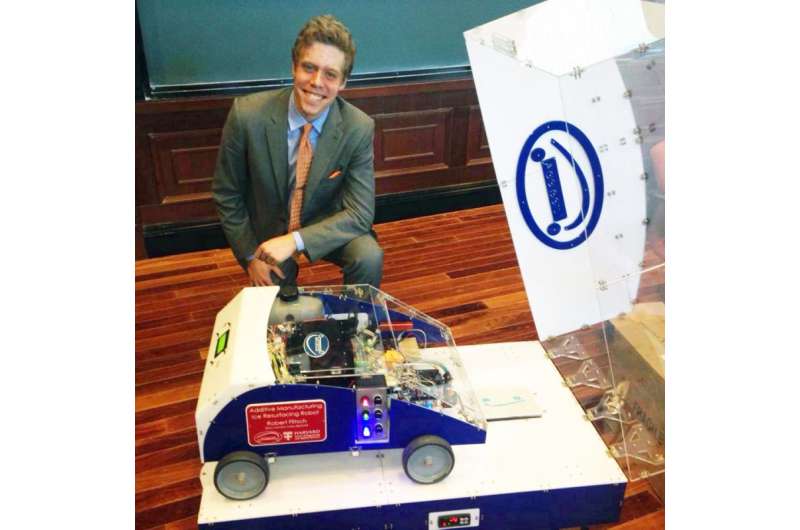January 22, 2016 weblog
On the road with a 3-D printer to help meet demand for repairs

Season after season, residents complain about the same ruts in pavements and potholes on the road, wishing they were repaired quickly. A startup engineer with a vision looks to 3D printing robots to save the day. Robert Flitsch is the inventor of the Addibot.
The company is Addibot LLC, a robotics and 3D printing startup and the product he has in mind is a small, wheeled robot capable of taking 3D printing to sites where it can change the surface from problematic to smooth.
The company posted an "ice resurfacing Addibot" video earlier this month. The machine was shown as designed to use water to 3D-print ice. The creator designed the 3D printing robots to drive over the surface of an ice hockey rink, resurfacing areas which had been chipped by skates. To print, water is cooled to just above its freezing point, then ejected onto the ice surface.
The little wheeled robot can drive over ice cut by skates and it additively prints inside the cuts, creating a smooth surface. "So long as the width of the print array accurately represents the crack or hole the Addibot is passing over, the repair work could be done at a constant speed on the order of a few miles per hour," said Flitsch in Popular Science.
He does not confine his company's future to repairing cracks on ice. Currently in development, Addibots are being targeted for use with different materials to repair other types of surfaces such as roads and sidewalks.
The road engineering models will be either human-controlled or autonomous. They will be engineered for repair and resurfacing tasks in roads. They could get involved with tasks such as crack repair, pothole repair, and seal coating for transportation departments and large road engineering firms.
"Underneath the chassis of an Addibot is an array of nozzles that, ostensibly, would lay down materials as needed to repair a variety of surfaces," said Andrew Zaleski in Popular Science. This printing robot uses raw material to build surfaces up layer by layer, "much like a boxy, desktop 3D printer would, but without the same space constraints."
In the bigger picture, his company could mark nothing less than a paradigm shift in additive manufacturing technology. "One of the main limitations with 3D printers is you typically have it printing inside this box, and you can really only print objects of the size of the workspace you're printing in," said Flitsch, a mechanical engineer.
If it seems ludicrous to have been tethered to a workspace in order to collect and relay information—before the advent of mobile technologies—why not think about breaking free from the confines of the 3D printing workspace. Printing robots on wheels would be a step in that direction.
After all, said 3Ders.org, "3D printers with the most advanced features, highest resolutions and largest build volumes tend to be large and heavy, which makes moving them around a real chore." In response, said the report, most 3D printer manufacturers have come out with compact models but these downgrade or downsize certain components. "But what if there was another way to increase the portability of a 3D printer, one which would not require the elimination or downgrading of any components?"
He has his technical challenges nonetheless if these machines hit the road. Dust is one of them.
"Keeping dust out of what the Addibot prints is a priority, since dust has a tendency to mess up 3D prints. Flitsch says he's working on incorporating a post-processing mechanism into the Addibot undercarriage that could ameliorate any problems dust might cause,"according to Popular Science.
Autonomous and semi-autonomous versions could ultimately be used to repair and even construct road surfaces.
The Addibot would be a great way to move caustic materials, like tar, farther away from the people who would be working on the roads, Flitsch added.
But wait, there's more. His vision does not stop with road repair.
He is thinking about the future of electric cars and how the wheeled robots might be useful. Nick Lavars expanded on this in Gizmag: What about the more advanced roadways in the future.
"The thinking is that to keep pace with advancements in transportation technologies, such as electric cars, we will need to rethink how the roads themselves are fabricated. By bringing 3D printing into the mix, it claims Addibots would be able to blend conductive materials into roadways for transmission of electrical power, for example, or add sensors to allow communication between vehicles. They could also make for more robust roads by printing materials for added strength, such as carbon fiber."
According to 3ders.org, the engineer hopes to have Addibots on the market within one to three years.
More information: www.addibots.com
© 2016 Tech Xplore



















